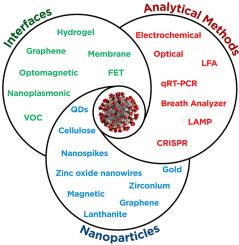Current Opinion in Colloid & Interface Science ( IF 7.9 ) Pub Date : 2021-05-29 , DOI: 10.1016/j.cocis.2021.101469 Ebru Saatçi 1 , Satheesh Natarajan 2

|
In March 2020, severe acute respiratory syndrome coronavirus 2 (SARS-CoV-2)-based infections were declared ‘COVID-19 pandemic’ by the World Health Organization. Pandemic raised the necessity to design and develop genuine and sensitive tests for precise specific SARS-CoV-2 infections detection. Nanotechnological methods offer new ways to fight COVID-19. Nanomaterials are ideal for unique sensor platforms because of their chemically versatile properties and they are easy to manufacture. In this context, selected examples for integrating nanomaterials and distinct biosensor platforms are given to detect SARS-CoV-2 biological materials and COVID-19 biomarkers, giving researchers and scientists more goals and a better forecast to design more relevant and novel sensor arrays for COVID-19 diagnosis.
中文翻译:

最先进的胶体颗粒和基于独特界面的 SARS-CoV-2 检测方法和 COVID-19 诊断
2020 年 3 月,世界卫生组织宣布基于严重急性呼吸综合征冠状病毒 2 (SARS-CoV-2) 的感染为“COVID-19 大流行”。大流行提出了设计和开发真正灵敏的测试以精确检测特定 SARS-CoV-2 感染的必要性。纳米技术方法提供了对抗 COVID-19 的新方法。纳米材料因其化学通用特性且易于制造而成为独特传感器平台的理想选择。在此背景下,给出了集成纳米材料和独特生物传感器平台的精选示例,以检测 SARS-CoV-2 生物材料和 COVID-19 生物标志物,为研究人员和科学家提供更多目标和更好的预测,以设计针对 COVID 的更相关和新颖的传感器阵列-19诊断。











































 京公网安备 11010802027423号
京公网安备 11010802027423号